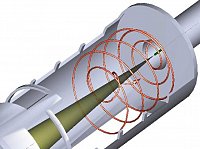Dust streaks in closed swirl flows
Title:
Behaviour of dust streaks in closed swirl flows
Head:
Prof. Dr.-Ing. M. Sommerfeld
Realizer:
Dipl.-Ing. J. Lipowsky
Keywords:
swirl flow, dust streak, experimental investigation, numerical calculation
Description:
In the scope of the proposed research project the behaviour of dust streaks in swirl flows in ducts has to be analysed. For this, the development, the expansion and the decay of the streak is important. Especially, the instationary behaviour of a streak has to be considered. The experimental investigations will be carried out using a simple swirling pipe with flow in axial direction. The swirl will be produced by a guide vane rim and the addition of the particles occurs in a centrical way. In the beginning, the behaviour of the streak has to be analysed with a simple visualisation technique. From this, information about the expansion of the streaks and their fluctuation in time can be obtained. Besides, detailed velocity measurements inside the streak using a Phase Doppler anemometry are planned. The method of Qiu et al. (1991) will be used for the simultaneous measurement of both phases. The time series of the measurements will be analysed further to understand the time behaviour of the streaks. Furthermore, the measurements should deliver information about the influence of the streak on the gas flow.
The numerical calculation of the swirl flow will be carried out with a three dimensional Euler/Lagrange approach (e.g. Huber & Sommerfeld 1998). An in-house calculation programme has to be expanded in a corresponding way considering the special circumstances in swirling flows. The turbulence will be described with a Reynolds stress turbulence model under consideration of the coupling between both phases (Kohnen & Sommerfeld 1997). Results of the other research groups for the turbulence modelling naturally will be included. In particular, the following aspects will be considered in an expanded modelling of the particulate phase:
- Improvement of the modelling of the particle dispersion in swirl flows under consideration of the anisotropy of turbulence. For this, the so-called Langevin model (Sommerfeld et al. 1993) should be expanded in an appropriate way.
- Coupled and time dependent calculation of the flow and the particle phase.
- Consideration and analysis of impacts between particles during the expansion of streaks.
The models developed and the result of the numerical calculations should be validated using the experiments carried out in parallel.

Swirl flows


